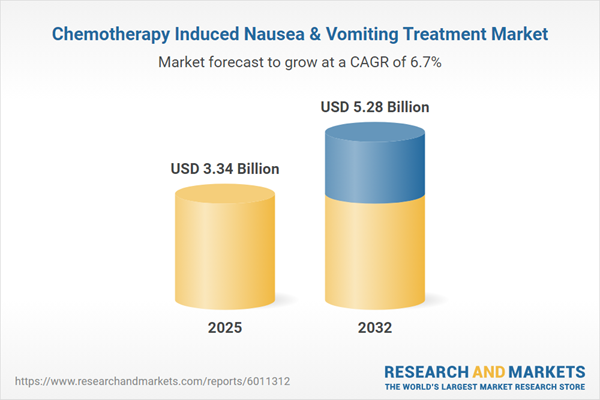Speak directly to the analyst to clarify any post sales queries you may have.
Senior decision-makers navigating oncology face mounting complexity as the chemotherapy induced nausea and vomiting treatment market adapts to evolving clinical, regulatory, and digital requirements. Strategic awareness is increasingly critical for organizations seeking to strengthen resilience, optimize care delivery, and gain market advantage within this fast-changing sector.
Market Snapshot: Chemotherapy Induced Nausea and Vomiting Treatment Market Size and Growth
The chemotherapy induced nausea and vomiting treatment market is currently valued at USD 3.13 billion and is expected to reach USD 3.34 billion within the next year. Forecasts indicate market expansion to USD 5.28 billion by 2032, equating to a 6.74% CAGR. Global growth is shaped by increasing cancer prevalence, ongoing innovations in antiemetic therapies, substantial pharmaceutical investment, and the incorporation of digital health platforms into oncology care. Reliable supply chain systems remain essential to ensure therapy availability in both major healthcare institutions and more localized community practices.
Scope & Segmentation: Market Structure and Core Drivers
- Drug Classes: A broad array of antiemetic agents—including 5-HT3 receptor antagonists, corticosteroids, dopamine receptor antagonists, and NK1 receptor antagonists—enables tailored therapy, supporting precision care matched to patient needs.
- Route of Administration: Both intravenous and oral formulations support provider and patient preferences, ensuring flexibility across diverse treatment settings.
- Therapy Types: Availability of monotherapy and combination regimens facilitates individualized treatment planning responsive to current clinical standards.
- Distribution Channels: Hospital, retail, and online pharmacies work in tandem to expand access, maintaining consistent therapy supply in urban, rural, and underserved markets.
- End Users: Hospitals, specialty clinics, and home care organizations deliver adaptable care for adult and pediatric oncology populations across various clinical settings.
- Emetic Risk Categories: Care protocols are informed by risk classification—high, moderate, low, and minimal—directing clinicians to optimal safety and efficacy pathways for each group.
- Patient Age Groups: Protocols for adults and pediatrics are designed to align with regulatory and safety requirements, supporting compliance and high-quality care delivery.
- Geographic Regions: North America, Europe, Middle East & Africa, and Asia-Pacific each bring unique trends in technology adoption, health policy, and clinical integration, shaping localized adoption and long-term opportunity.
- Key Companies: Leading firms including Merck & Co., Eisai, Helsinn Healthcare, GlaxoSmithKline, Heron Therapeutics, Teva, Sandoz, Mylan, Dr. Reddy's, and Sun Pharma continually refine portfolios to respond to evolving regulatory and clinical demands in their operating regions.
Key Takeaways: Strategic Insights for Senior Leaders
- Flexible treatment protocols allow organizations to quickly adapt to emerging clinical guidelines, improving standardization and responsiveness across multiple care environments.
- Digital monitoring platforms enhance patient engagement and support adherence throughout chemotherapy cycles, offering value in both acute and long-term care.
- Interdisciplinary cooperation among pharmacy, oncology, and nursing teams fosters consistency and high-quality care across healthcare networks.
- Personalized therapeutics, tailored to patient and disease factors, promote improved recovery pathways and help mitigate complications.
- Regional variability in infrastructure, reimbursement, and regulatory landscapes requires adaptive strategies for successful market entry and scalable operations.
Tariff Impact: Supply Chain and Procurement Strategy
Ongoing adjustments to United States pharmaceutical tariffs continue to shape procurement practices, prompting healthcare organizations to strengthen domestic supplier alliances and streamline operational workflows. Agility in policy response safeguards therapy continuity and prevents supply disruptions, supporting uninterrupted patient care.
Methodology & Data Sources
This analysis draws on insights from oncology and pharmacy leaders, assessment of emerging clinical best practices, and immediate tracking of regulatory changes. The report is designed to equip senior executives with granular, actionable intelligence for decision-making in the chemotherapy induced nausea and vomiting treatment market.
Why This Report Matters
- Delivers evidence-based recommendations to inform antiemetic therapy selection and strategic planning for healthcare executives and providers.
- Clarifies the impact of supply chain and tariff dynamics, supporting the development of robust procurement and entry strategies in shifting markets.
- Empowers confident investment and regulatory approaches with sector-specific analysis relevant to evolving market needs.
Conclusion
This report enables senior leadership to anticipate and manage regulatory, clinical, and operational shifts in antiemetic therapy. Actionable insights support informed decision-making for long-term growth and market resilience.
Additional Product Information:
- Purchase of this report includes 1 year online access with quarterly updates.
- This report can be updated on request. Please contact our Customer Experience team using the Ask a Question widget on our website.
Table of Contents
3. Executive Summary
4. Market Overview
7. Cumulative Impact of Artificial Intelligence 2025
Companies Mentioned
The companies profiled in this Chemotherapy Induced Nausea & Vomiting Treatment market report include:- Merck & Co., Inc.
- Eisai Co., Ltd.
- Helsinn Healthcare SA
- GlaxoSmithKline plc
- Heron Therapeutics, Inc.
- Teva Pharmaceutical Industries Ltd.
- Sandoz International GmbH
- Mylan N.V.
- Dr. Reddy's Laboratories Ltd.
- Sun Pharmaceutical Industries Ltd.
Table Information
| Report Attribute | Details |
|---|---|
| No. of Pages | 192 |
| Published | October 2025 |
| Forecast Period | 2025 - 2032 |
| Estimated Market Value ( USD | $ 3.34 Billion |
| Forecasted Market Value ( USD | $ 5.28 Billion |
| Compound Annual Growth Rate | 6.7% |
| Regions Covered | Global |
| No. of Companies Mentioned | 10 |









